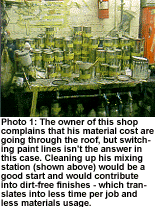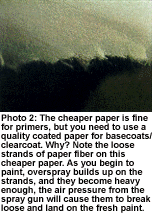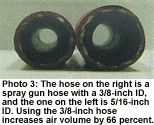You just received your latest P&L. You look at your materials cost and pick up the phone to dial 911. OK, you take a deep breath, decide against calling 911 and, instead, call a paint company you don’t usually do business with to try getting a better price on paint. It turns out you can — so now you switch paint brands.
But are you really going to reduce your material cost by switching paint lines?
Probably not.
If you really want to reduce this cost figure, you need to understand what’s going on in your shop. Look at Photo 1 on page 66. Does your shop look like this? The facility in this picture is on numerous direct-repair programs (DRPs) and moves a lot of vehicles. Do you think this shop owner would save money by switching paint companies? No way. The paint he uses isn’t the problem here.
So how can you save money? This article shows you some procedures, methods and products that can give you nearly dirt-free paint on most of the paint jobs your facility performs, which translates into less time per job and less materials used. My painter uses everything that will be outlined in this article, and all he does is nib the paint. (Once in a while, he’ll have to color sand.)
Cruddy Car = Dirty Paint
The major source of dirt on a paint job is from the car, so power wash all vehicles. (You need at least a 1,000-psi pressure washer.) If it’s possible, power wash a car before it goes to the body department, and when you wash the car, pay particular attention to the wheel wells and undercarriage.
Next, use a white, lint-free cloth to to remove any oil, waxes, silicones and other foreign matter on the vehicle surface. (You have no idea what those recycled shop towels were used for before you got them! Because cotton tack rags shed materials, use tack rags made from nylon.) All the major paint companies recommend using one cloth to wipe and a separate one to dry.
Once the body work is completed, power wash the vehicle again to get rid of the "bondo" dust and any dirt that’s been dislodged from hammering, grinding and air chiseling. An hour of preparation now can save you hours of correction later. (Try to wash the vehicle the day before it’s to be painted because water that’s present during the bake cycle will wreak havoc on paint.)

Cheapskates = Dirty Paint
Now the car’s ready to be masked. How many of you use cheap tape to save a buck? Tsk, tsk … During the bake cycle, the adhesion material will likely separate from its backing, and now someone has to spend extra time cleaning up molding, rubber, handles, etc. Sure, it saved you a buck, but how much does that extra, non-reimbursed labor cost you? A heck of a lot more. Cheap tape also tends to lift off during the bake cycle, allowing a bridge to form between the clear on the body and clear on the tape. Guess what happens when the tape is removed? My painter uses a quality fine-line tape around all moldings, emblems, windows and other areas that are subject to a high build-up of clear.
Speaking of cheap items to avoid, how many of you use cheap green paper in the paint booth? If you answered yes, stop it! You need to switch to quality paper, and here’s why: Look at Photo 2 on page 68. Note the loose strands of paper fiber. As you begin to paint, overspray builds up on the strands. When they become heavy enough, the air pressure from the spray gun will cause them to break loose. Where will they land? You guessed it, right on the fresh paint!
The green paper or cheap paper is great for primers, but when it comes to basecoat/clearcoat, you need to use quality coated paper. I ran some numbers, and the difference in cost on an average repair between the green and quality coated paper we use nets out at about $1.50 more per vehicle. At today’s labor rate, that translates into about .1 of an hour, or six minutes. But how much time is needed to clean up bleed-through clear or defects caused by those "fuzz ups"?
Another item that can produce dirt in the paint are your wipe rags. It’s imperative that your painter use high-end wipes. The last thing you need is fibers coming off the wipe, floating around the booth and landing on the paint.

Mistakes in Mixing Room = Dirty Paint
Another source of contamination is the mixing room. Your mixing room must be kept clean at all times and needs to be well-lit and ventilated. Don’t store polishes, cutting compounds, waxes or other related detail materials in your mixing room. Why not? They’re a major source of fish-eyes (silicon-base materials). Silicon particles float a long way, and if you have my luck, will land directly on that freshly painted car.
How about those free strainers from your jobbers? I particularly like the ones with their names on them. Get rid of them. They’re usually made from cotton, and I think by now you know where I’m going. Cotton fibers become dislodged and end up in the paint, which in turn is sprayed on the vehicle. Now your painter will have to remove the dirt (labor) from that free strainer. The best strainers are ones made from fine nylon.
Another freebie that’ll cost you in contamination problems is a wooden stir stick, which tends to splinter. You may not be able to see the splinters with the naked eye, but you’ll notice the contamination later in your paint work. Use a plastic mixing stick instead — and remember to keep it clean!
A few other commonsense procedures should also be utilized in the mixing room:
• Keep all reducers and clear containers closed. Contamination gets into open containers.
• Don’t cover the mixing table with cardboard or paper. Fibers can stick to the gun cup and then get transferred into the spraybooth. For the best results, use a tabletop made from stainless steel.
• Keep all mixed paint covered to prevent contamination. Hardeners that are left open can combine with moisture and allow small crystals to form — which can end up on the final clearcoat.
• Dust off all cans before opening them.
• Make sure the solvent in your gun washer is fresh. Residue can become lodged in the gun during the cleaning process, and when your painter goes to spray the next job, these residue droplets will land on the paint.
• Thoroughly clean spray guns!

Spraybooth Blunders = Dirty Paint
The first thing I did when I started working at this facility was to start a maintenance schedule book. I changed all the filters in the prep stations, spraybooths and heater, and I made the painter responsible for maintaining an up-to-date book.
• Daily: We sweep out the booth once a day, and spray the floor with a dust-control product two times a day.
• Weekly: Once a week, we wash down the walls.
• Regularly: We change all filters on a routine basis.
• Yearly: At the one-year mark, I have a spraybooth maintenance company come in to service the entire system.
You should remove tables, racks, shelves and other miscellaneous items from your spraybooth, since these items are major sources of contamination. Also, keep the doors closed at all times, except when loading and unloading a car. If you’ve just finished the bake cycle and are removing a car, the heat will cause a reverse flow in the booth and any dirty air will be sucked back into the booth.
After placing a vehicle in the booth (try to position the car in the center of the booth at all times), a couple of procedures can help eliminate dirt:
• Ground the vehicle. In other words, take a battery jumper cable and run it from the car to the grates (make sure you don’t attach the cable to any plastic parts). As air moves over the car at a high speed, static electricity develops and the car becomes charged, which in turn attracts dirt to the car. By grounding the car, you’ll reduce this effect.
• Do a final de-grease, and tack of the car using a low air pressure.
Now’s a good time to look at air hoses. Look at Photo 3. The interior diameter (ID) of the one on the left is 5/16 inch. The hose on the right is a spray gun hose with a 3/8-inch ID. Most shops use the cheaper 5/16-inch ID hose in their spraybooth. Big mistake. Using the 3/8-inch hose increases air volume by 66 percent.
Today’s HVLP spray guns need volume, and by using the smaller and cheaper ID hose, you restrict the air — resulting in heavier orange peel and increased materials usage. Another tip about hoses: When you’re finished painting, get the hose off the floor. If you leave it on the floor and drive over it, it eventually breaks down internally and the particles end up on the paint job. Do you tack down your air hose? If not, you should.
Linty Painter = Dirty Paint
Another major source of paint contamination is the painter. Does your painter paint in street clothes? Does he paint without covering his hair? If you answered yes, you have a contamination problem.
A good friend of mine who works at a spraybooth company conducted a spraybooth clinic a couple of years ago. He took a painter wearing street clothes into the booth, turned on the fans, turned off the lights, and using a "black light," demonstrated to all of us the amount of lint and dirt that came off the painter’s clothing. These floating particles pick up overspray and eventually land on a paint job.
A painter must wear a lint-free suit, preferably one that covers his hair. Cotton — as you know by now — gives off lint.
Error in the Air = Dirty Paint
Another area that can be a major contamination source is your air supply/compressor. Older compressors work harder and create more heat, which in turn heats up the air. As the hot air cools, condensation forms in the tank and lines and, if it’s not properly addressed, will land on your paint job. You need to drain your tank on a daily basis (there are automatic drainers on the market that work by timers). Adding a refrigerant dryer to your air supply also will go a long way in reducing in-line contaminants. You can add a desiccant dryer system at the booth, but make sure it doesn’t use a silicone-based medium. Your painter can also use an in-line filter at the spray gun.
Knowledge = Flawless Finish
To prevent contamination of your paint jobs, carefully consider all the tips in this article — and incorporate them into your refinishing process.
Dirt is everywhere. But if you’re smart, one place it won’t be is in your finishes!
Contributing editor Toby Chess, AAM, is director of technical training for Caliber Collision Centers. He’s also the Los Angeles I-CAR chairman, an I-CAR instructor and a certified ASE Master Technician.













